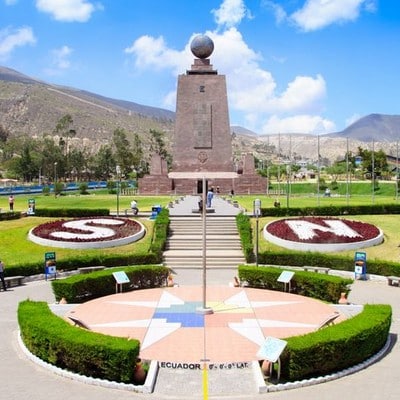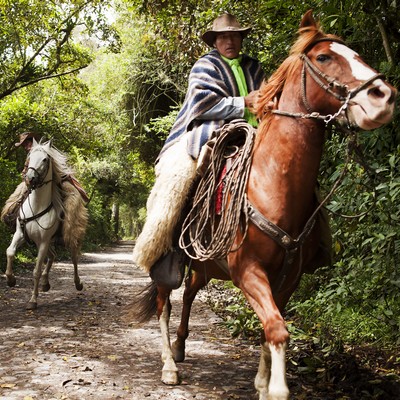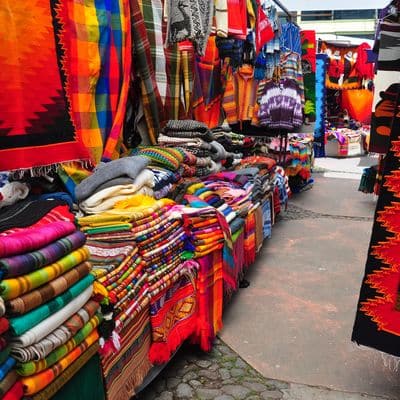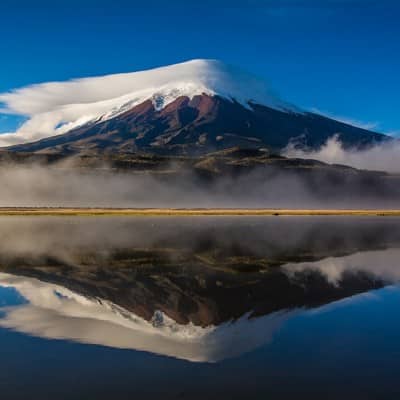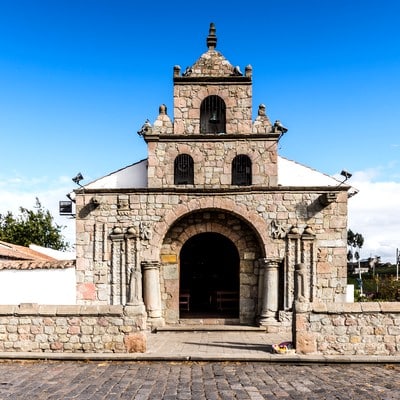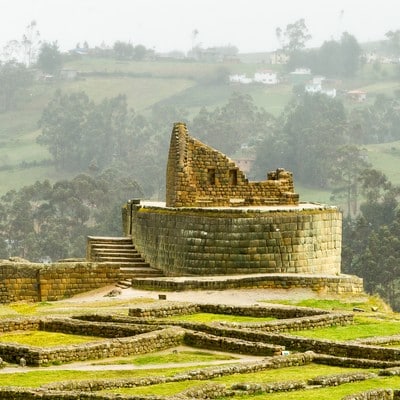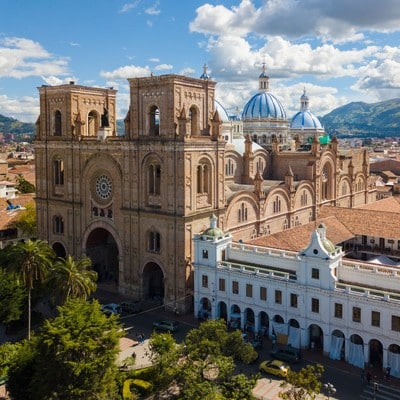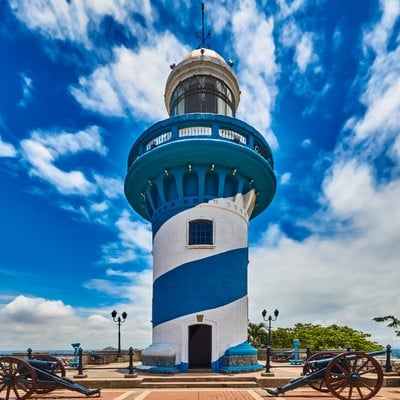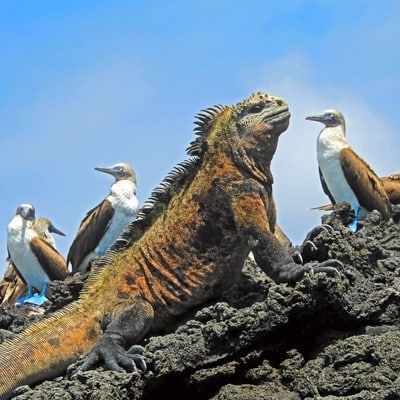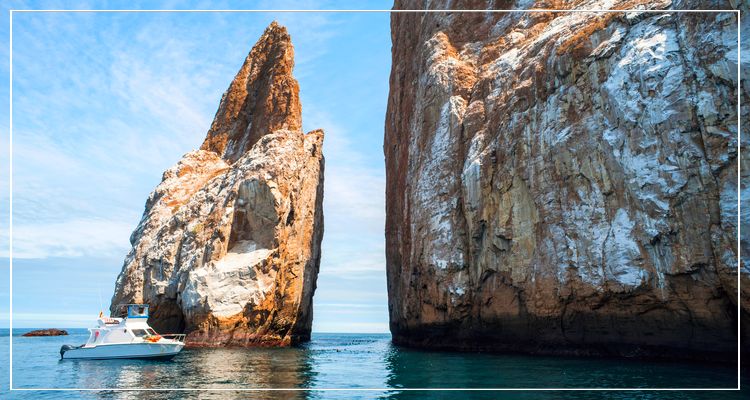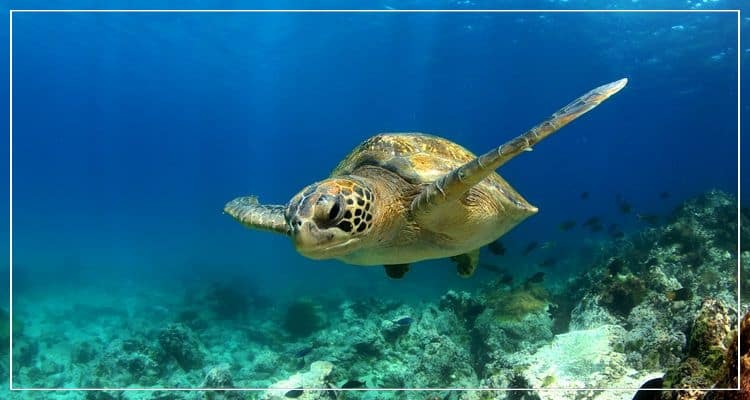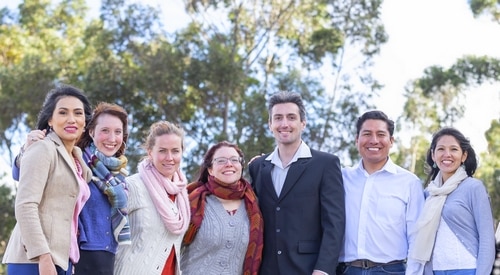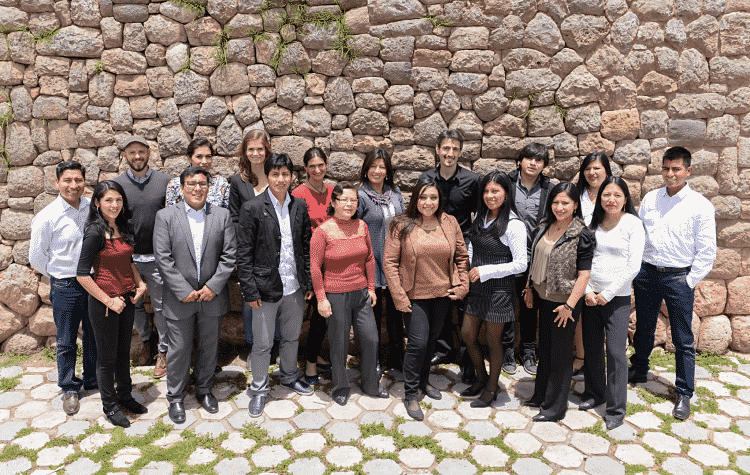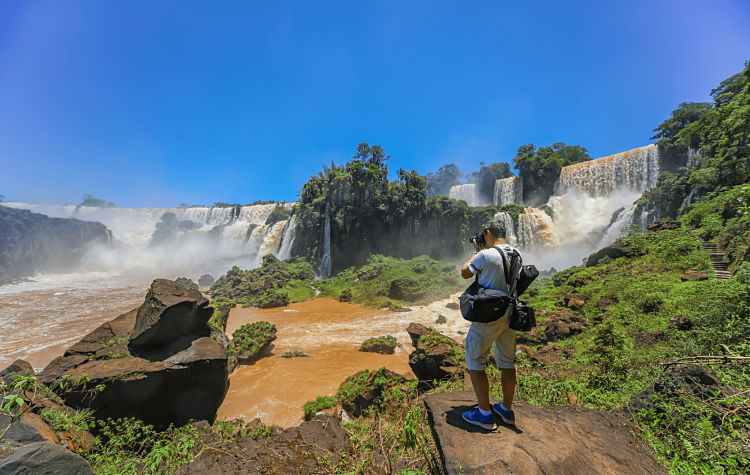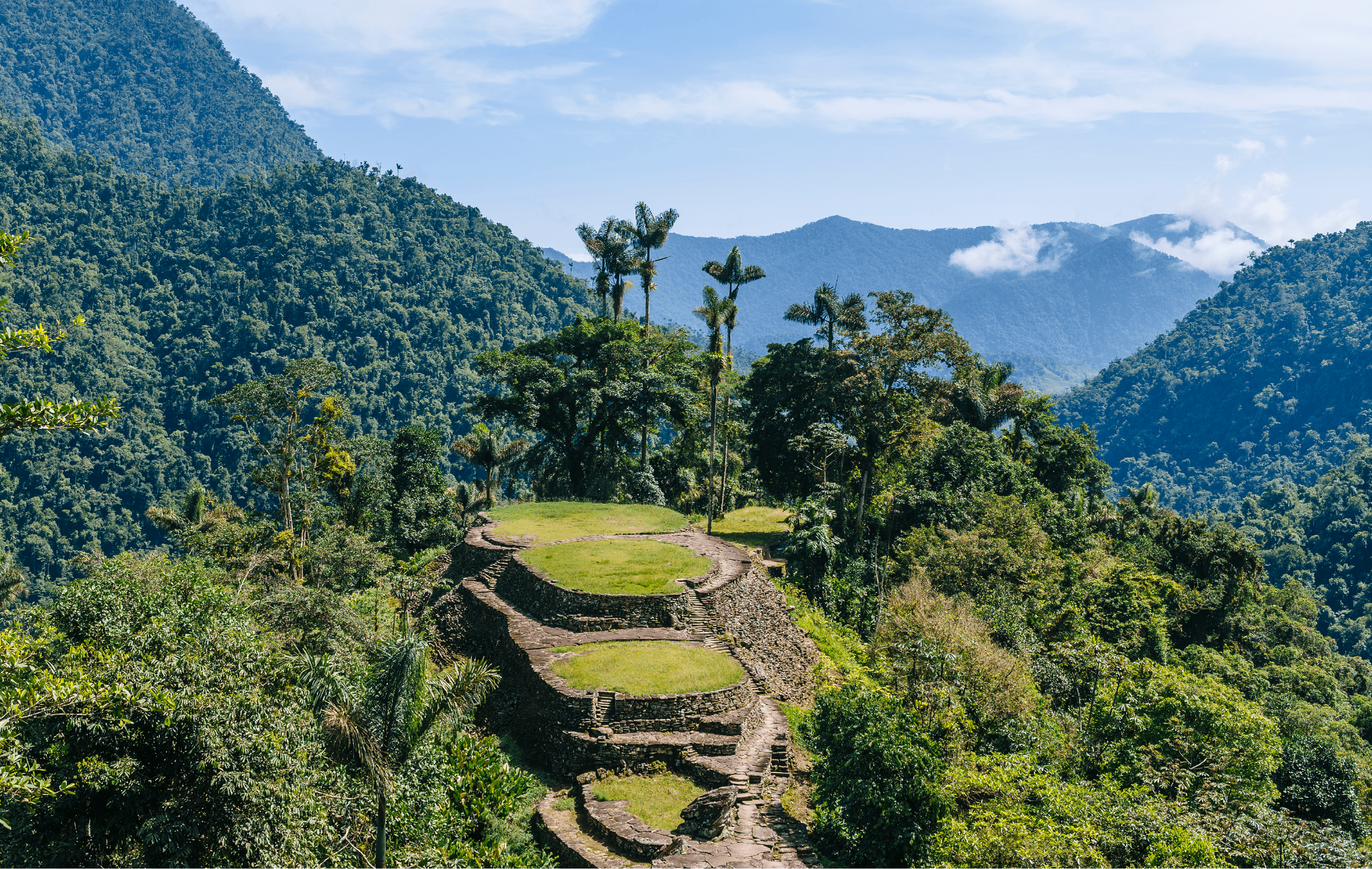QUITO
HACIENDA ZULETA
OTAVALO
COTOPAXI
RIOBAMBA
INGAPIRCA
CUENCA
GUAYAQUIL
GALAPAGOS ISLAND
- Dive into Quito’s rich colonial past in the city’s UNESCO-listed historical core.
- Hop between hemispheres at the Middle of the Earth Equator marker.
- Chat with local artisans and hunt for a bargain at Otavalo, the setting of South America’s oldest, largest and most famous market.
- Marvel at the series of majestic peaks that line the so-called Avenue of Volcanoes.
- Explore captivating Inca archaeological sites.
- Be charmed by the characterful cobbled streets of colonial Cuenca, a city often dubbed the “Athens of South America”.
- Travel by luxury yacht between the Galapagos Islands – where Charles Darwin’s revolutionary theory of evolution was born.
- Face to face encounters with exotic wildlife such as the Giant turtles, the Blue-footed Boobies and much more all throughout the Galapagos Islands!
- Discover hidden treasures as you snorkel pristine beaches.
- Take your pick from a range of luxury hotels, lodges and accommodations.
- DAY 1 - Welcome to Ecuador!
- Day 2 - The History of Quito
- Day 3 - Out of Quito to Zuleta
- Day 4 - Hacienda Zuleta
- Day 5 - Native Towns
- Day 6 - Cotopaxi National Park
- Day 7 - Beautiful Scenery
- Day 8 - Cuenca Bound
- Day 9 - Cuenca
- Day 10 - Cuenca to Guayaquil
- Day 11 - Guayaquil
- Day 12 - To the Galapagos Islands!
- Day 13 - Galapagos Islands
- Day 14 – Galapagos Islands
- Day 15 - Galapagos Islands
- Day 16 - Galapagos Islands to Quito
- Day 17 - Homeward Bound
Quito, the capital of Ecuador, is one of the most beautiful cities of Ecuador. It is divided into the old or colonial city and the modern city. The Colonial Quito is still reminiscent of how it was 450 years ago, even though it is a small island surrounded on all sides by a fast-growing modern city. In colonial Quito are narrow cobblestone streets lined with whitewashed walls over which the steeples and cupolas of historic churches and a cathedral sites. The integrity of colonial Quito was assured in 1978 when the United Nations declared the city a World Cultural Heritage Site.You will find us waiting for you when your international flight arrives in Quito. We will escort you to your hotel, check you in and help you get settled. You’ll then be able to rinse away the feeling of a long flight and enjoy a good night’s rest!
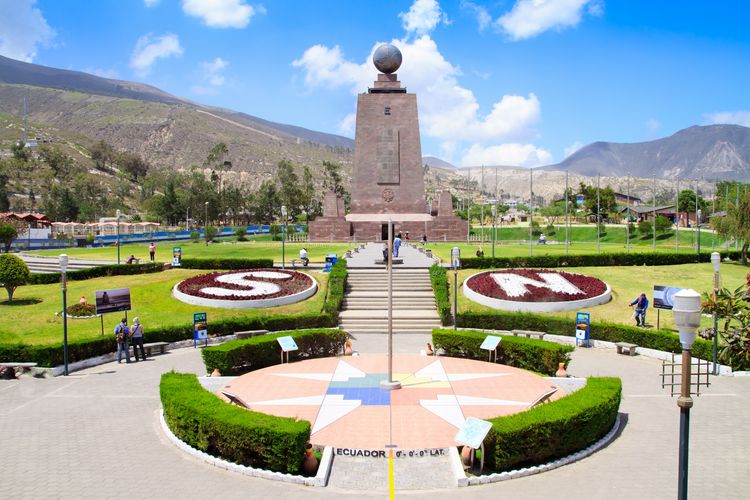
On this one-day tour, we will visit the historic district of the Ecuadorian capital, enjoying this urban jewel and its artistic and architectural treasures. One of the largest and best preserved colonial centers in South America, Quito’s “Old Town” area was declared the first “World Heritage Site” by UNESCO, in 1978. The visit to the historic center begins with the Basilica del Voto Nacional, one of the largest churches in Ecuador and one of the most important works of Ecuadorian neo-gothic architecture. While the outside of the building stands out for its stone carvings that represent plants and animals of the country, the inside consists of 24 chapels.
We will continue on to the always vibrant Plaza Grande (“Independence Square”), which is surrounded by the Cathedral, the Presidential Palace, the Municipal Building and the Archbishop’s Palace. We will then visit the church of the “Compañia de Jesus” to find its impressive interior inlaid in gold. Your tour of historic Quito will end with a birds-eye view of the city from the panoramic “Virgin of Quito” monument atop El Panecillo Hill, which overlooks the capital. This will give you a chance to appreciate Quito from above, and – if the weather permits – to catch a view of the spectacular “Volcano Avenue,” two parallel mountain ranges containing eight of the country’s ten highest peaks.
Then, you will visit the shop of one of the best chocolate companies in Ecuador and also one of most awarded in the world, Pacari for a tasting experience. The organic chocolate is blended with Andean flavors like: lemon verbena, gooseberry and Andean blueberry. Likewise, traditional flavors from neighboring countries are used: Chile merkén (Mapuche chili) and the pink salt Maras (an ancient salt from nearby Cusco).
From here, we will continue our journey 15 miles north of Quito to the Mitad del Mundo (“Middle of the World”), the monument on the equator that was built to commemorate the French scientists who in the 1830s made history by determining the shape of the planet thanks to their studies at this location.
The highlight of this visit is the equatorial line running along latitude of 0° 0’ 0.” Here, you will be able to stand with one foot in each of the earth’s hemispheres – a great photo op! We will also visit the Intiñan Solar Museum, where you will have the opportunity to perform various unusual experiments like balancing an egg on a nail, losing weight in a second, or straddling the equatorial line that separates the two hemispheres. After the visit, we will drive you back to your hotel.
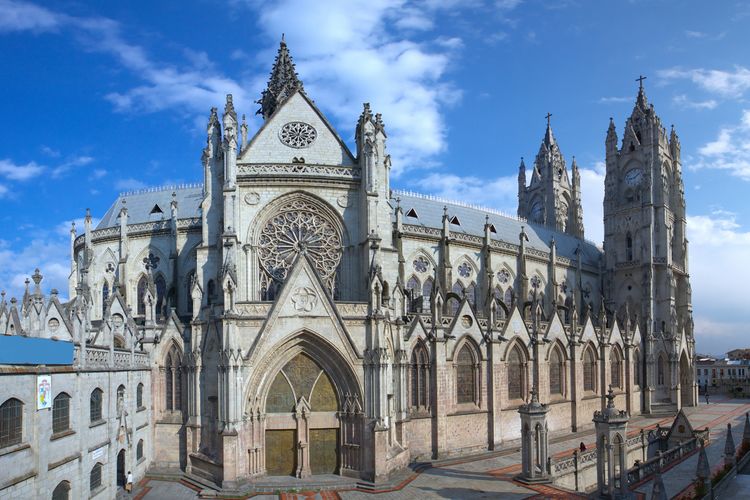
After breakfast, you will head north along the Pan-American Highway making a brief stop in the town of Cayambe to visit a rose plantation. Owing to the quality and variety of its roses, Ecuador is considered one of the countries with the best of these flowers for export. Because of these flowers’ beauty, many nurseries have also decided to become involved tourism activities, showing off the more than 300 varieties of roses grown here – some with stems extending more than six feet high!
You will head to east until reaching the Hacienda Zuleta. You arrive at the hacienda in the afternoon after a drive through lush highlands pastureland. With some luck, on your way you will have enjoyed stunning views of the snow-capped Cayambe Volcano, which is just a few miles away from Zuleta. Your host will welcome you personally at Zuleta and, after checking in to your room, he/she will explain the activities offered at the hacienda. While having some afternoon tea or coffee with you, they will also find out about your personal preferences, needs or questions.
After planning your stay, you will be given a tour of the main building, learn more about Zuleta’s history, see the private library of Ecuador’s ex-President Galo Plaza Lasso, and wander through the beautiful gardens and chapel.
As sun sets it gets chilly at Zuleta, so enjoy some wine and farm-made Ecuadorian cheese beside the fireplace while reading our information folders and books, learning more about our foundation, Galo Plaza, our horse breeding business or about the local culture of Ecuador in the highlands. Finally, you can end the day with a nice hot bath.
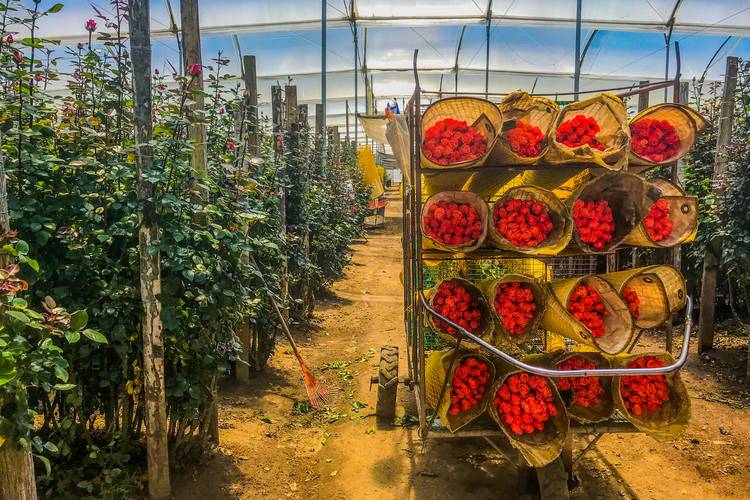
After an exquisite breakfast of eggs, pancakes, muesli, fruit and homemade bread, you will be able to visit the cheese factory. Here, you can learn more about Zuleta´s semi-aged, handmade Ecuadorian cheeses and how the process has changed throughout history.
As mornings are usually sunny throughout the whole year, it is best to take advantage and use this time to take the Condor Tour, by hiking or biking to the condor reserve. In the mornings, you are most likely to spot an Ecuadorian wild condor flying by. The reserve is located 3 km from the guesthouse, in a native forest valley.
The route back takes us through pastureland where we pass between ancient pyramids of the Caranqui culture; seeing both small burial mounds dating back to 700 A.D., and giant ceremonial truncated ramp pyramids from the 13th century.
If you love horseback riding, today could be your day! This is an activity offered at extra cost, and can be booked in person at the hacienda.
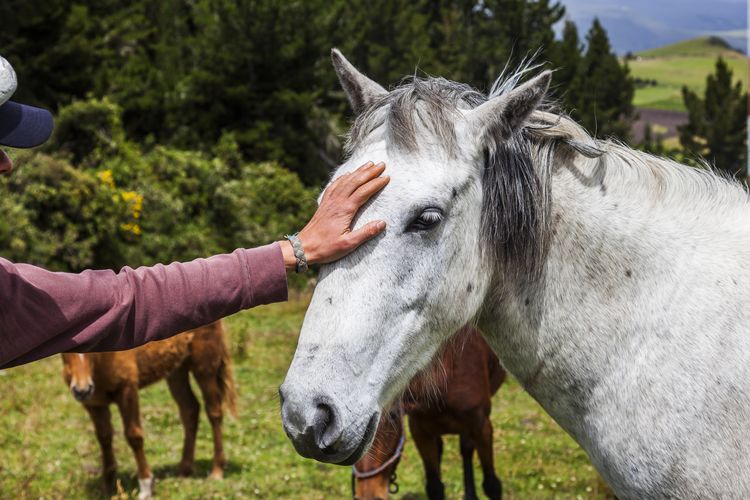
We begin today’s trip to the town of Otavalo, home to Ecuador’s largest indigenous market and one of the best known in all of Latin America. The market sets up every day, allowing you to spend a few hours wandering through these bustling handicrafts center, in addition to its food stalls.
We will then visit a family of weavers in the nearby village of Peguche who not only have amazing wares but will actually demonstrate how they weave on their traditional back-strap looms and show you their techniques for making striking colors from local plants. Around the corner lives a family of musicians, where you’ll get a feel for Andean music and watch as perfectly tuned Andean flutes are crafted in minutes.
We will have lunch in a typical Ecuadorian restaurant before going to Cotacachi town, famous for its leather crafts, and then visit the nearby beautiful volcanic Cuicocha Lake where we can have a short hike and an optional boat ride around the lake.
In the late afternoon, we will arrive at the famous Hacienda San Agustin de Callo, for dinner and overnight. There are few places in Ecuador that make such an impression when visiting them. From its archaelogical relevance to the delicacy with which each room has been decorated and arranged – with fireplaces to warm the bathrooms or artistically painted walls to distinguish each space – San Agustin de Callo is a place of fascination. Llamas enliven the central patio, where they look for carrots during their lunch hour and flowery gardens are lit in front of the vision of Cotopaxi, when it emerges from a clear sky. But it is, perhaps, the Inca site on which this lodge stands, with its prodigious carved stone walls, that reall makes this Andean hacienda unique. Add to it the excellent food, the rural and secluded setting, walks in the moor, visits to the orchard, cycling and horseback riding… in short, a place to treasure a lifetime.
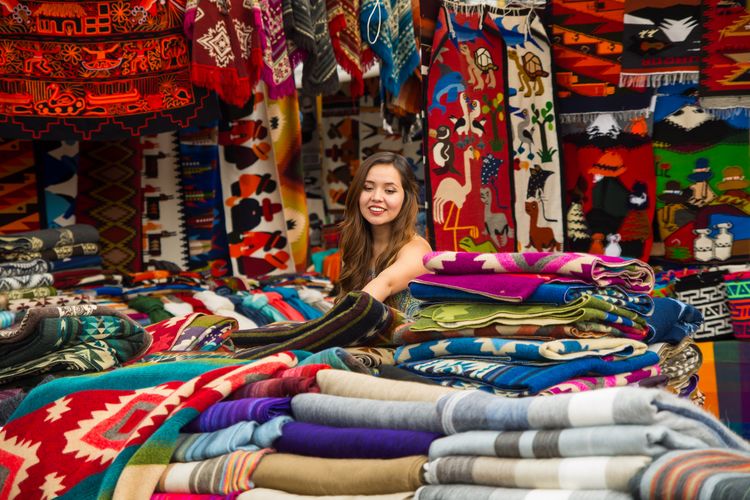
After a delicious breakfast, you will have the chance of witnessing Cotopaxi colossus, which is covered by layers of snow and ice, and is known for its perfectly symmetrical cone. This imposing giant is often the backdrop for the landscapes of the central highlands and possesses a history of dramatic eruptions, which are reasons why many people visit this mountain. However, its beauty and the physical and technical challenge that it represents for mountaineers is what makes it special among those who engage in this sport.
The volcano, which has recorded several eruptions in its history and is now moderately active, is situated within Cotopaxi National Park, located on the beautiful plateau of the Ecuadorian highlands. Here, you can find wild horses grazing on vast plains at the foot of the volcano or gathering to drink the calm waters of Lake Limpiopungo. Enjoy this incredible view and experience the intense and unique feelings that inevitably evoke contemplation of this mountain landscape. If you love the mountains, this tour will be an ideal introduction to one of the world’s challenging volcanoes.
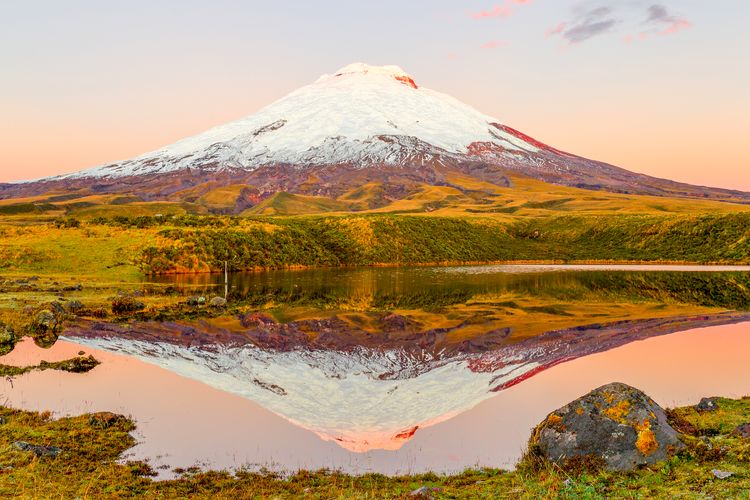
Today we will take a two-hour car journey through the western Andes mountain range, one of the most impressive areas of Ecuador. Heading south, the tour will take us to Zumbahua, a small colourful town consisting of just 40 families.
Ten kilometers farther lies the blue and green Quilotoa Crater Lake, one of the most beautiful volcano lakes in the Ecuadorian Andes. From the crater you can see various snow-topped volcanoes in the distance. After a 1-1/2 to 2-hour hike down to the bank of the lake, you will enjoy a traditional lunch. Later we will continue driving southwards, reaching the Riobamba area in the afternoon, where you will check in at your hotel for the night.
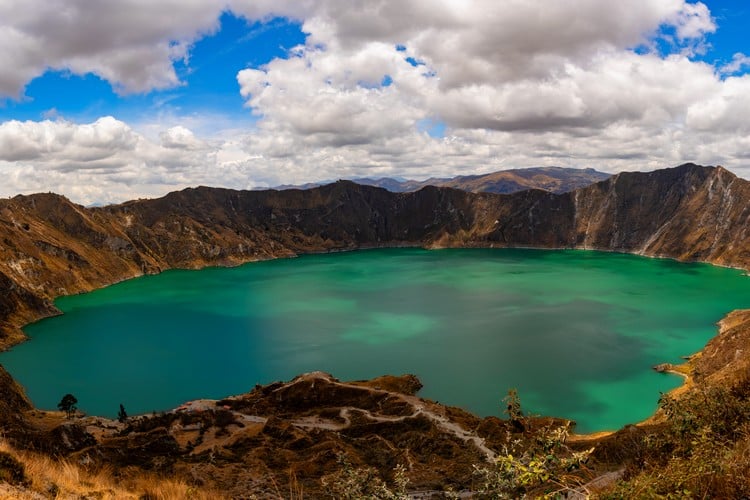
After breakfast, you will be taken to the Riobamba train station to begin a breathtaking rail journey through the mountains to Chanchán. The railway line was completed in 1902 and is the steepest railroad in the world…a true technical masterpiece! The train travels through beautiful countryside, with the highlight being the stretch known as the “Nariz del Diablo” (the Devil’s Nose). You will disembark at the station in Chanchán, and from there we will travel to the charming city of Cuenca.
On the way, you will stop at the famous archaeological site of “Ingapirca” (Kichwa for “stonewalls of the Inca”), the most important and best preserved Inca ruins in Ecuador. Here, you can wander around this fascinating site and visit the small museum. Afterwards, we will drive for another two hours until reaching Cuenca and your hotel.
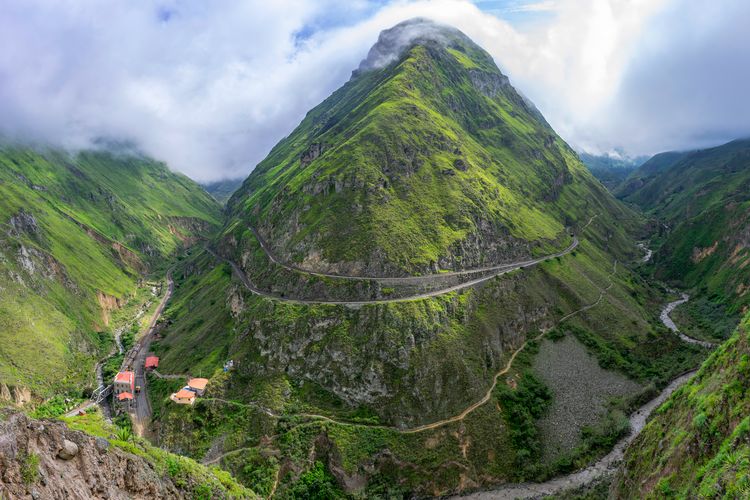
After breakfast, you will begin a tour that explores the colonial center of Cuenca. The third largest city in Ecuador (after Guayaquil and Quito), Cuenca is considered by many as the artistic and cultural center of the country. This visit to Cuenca’s historic district will give you a chance to see its remarkable colonial and republican architecture, as well as its sacred art museums and markets, particularly the flower market. Cuenca is a good place to purchase another famous Ecuadorian souvenir: the “Panama” hat (which actually originated here in Ecuador). These hats are sold at fair prices in several government-approved franchise shops in town. Cuenca is also a good place to buy ceramics, embroidery, leather goods and baskets.
In the afternoon, we will visit Chordeleg (from chorro de oro, meaning “waterfall of gold”), where you’ll learn about the production of fine filigree jewelry as well as handmade ceramic pottery. While in Gualaceo, you’ll have the opportunity to wander through local fruit and vegetable markets brimming with fresh produce, as well as learn about (and taste!) delicious fruit grown only in Ecuador.
Another highlight of this trip is a visit to Ecuagenera, the most important orchid growing laboratory in Ecuador. Take the time to marvel at hundreds of exotic species — from the exquisitely tiny to the outrageously colorful — as you tour the facility and learn about the propagation and preservation of these enthralling plants.
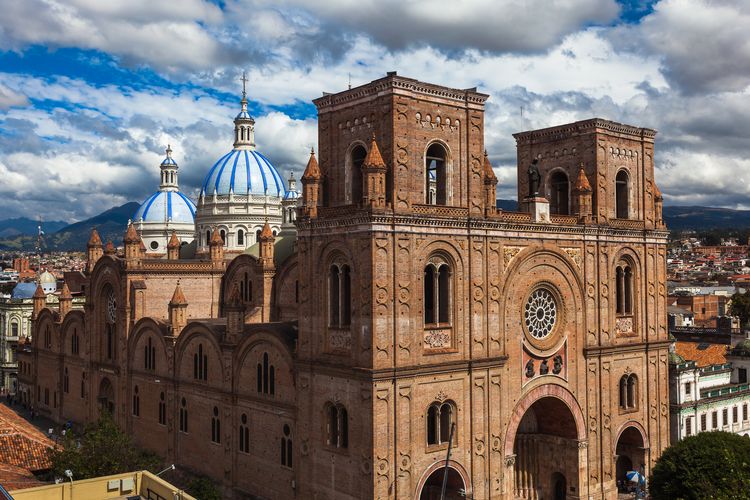
This morning we will drive from Cuenca to Guayaquil, en route stopping to visit Cajas National Park. Here, you will find a network of around 200 lakes left over from the Ice Age. Today these form part of an extensive recreation area at a height of 3,150 to 4,450 meters above sea level. Connecting these lakes is a series of small rivers that eventually flow into either the Pacific or the Atlantic oceans.
Later we head to Guayaquil, Ecuador’s largest city, and check-in at the Boutique Hotel del Parque. Imagine a veritable time capsule hidden away from the hustle and bustle of the great Pacific port of Guayaquil. In the 1980s, historic buildings threatened with destruction were moved, rebuilt and renovated plank-by-plank on the banks of the Daule river. Hotel del Parque was one of these buildings. Today, you can discover it standing elegantly, wrapped in the tropical bosom of a vast botanical garden. Sitting on the waterfront, the hotel’s restaurant, Casa Julián, specializes in the finest seafood and freshest fish. Having embraced the local culinary tradition of soups and stews, its chef is also known to skillfully play with the flavors and textures of avocado, banana and cocoa.
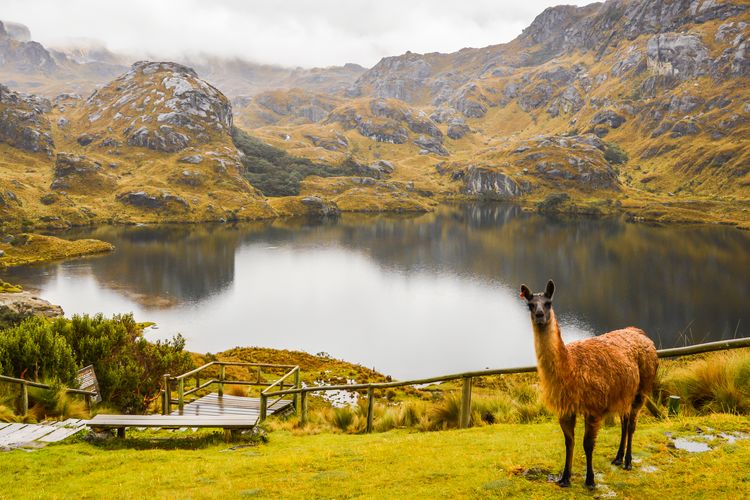
Guayaquil, the gateway to the Galapagos, has been transformed over recent years with its newly restored historic district characterized by centuries-old houses and narrow lanes. Las Peñas is the city’s oldest district, and once you’ve navigated its colourful streets you’ll be guided up 444 steps to the summit of Cerro Santa Ana for panoramic vistas of the city.
As well as this Guayaquil cradles a string of excellent museums, a stately cathedral, Iguana Park (named after the resident creatures here) and the modern Malecon 2000 which hugs the Guayas River and is home to the towering Moorish Clock Tower, botanical gardens and Chamber of the Rotunda.
This monument marks the historic meeting between Simon Bolivar and Jose de San Martin in the 19th century, reflecting a huge turning point in the history of the country. Sprawled over eight hectares and flanked by the Babahoyo and Daule Rivers, the Guayaquil Historical Park is a fascinating window into the wildlife, architecture and history of Ecuador.
It was established by the Central Bank to preserve the culture and customs of Guayaquil and the coast, and is divided into three distinct sections. The Wildlife Zone is home to more than 50 species of bird, mammals, reptiles, plants and insects, reflecting the four different ecosystems of Ecuador: mangrove forest, flooded plains, tropical dry forest and drizzle forest. Then there’s the Urban Architecture Zone, with restored and reconstructed buildings from the turn of the century.
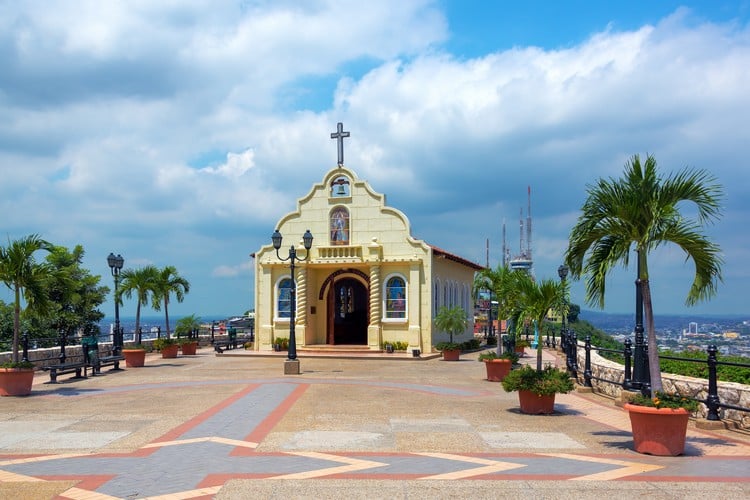
The Galapagos Islands are among the most amazing natural places in the world, and this group of 13 major islands and dozens of smaller islets and rocks, all the result of volcanic activity, certainly appears to be out of this world. The islands are in fact, an unpredictable wilderness, a living laboratory of evolution filled with an extraordinary population of unique species, which have developed apart from human influence. For nature lovers, the perfection is even greater, birds and more birds, playful sea lions, exotic plant life, volcanoes and haunting land seascape.
Early this morning we will escort you to the national airport in order to board flight to the wondrous Galapagos Islands (approximately 2.5 hours). Upon arrival in the archipelago at the Baltra airport, a member of the crew will welcome you and accompany you to your ship: the Ocean Spray motor vessel.
PM: Later, upon arriving on Bartolome Island, we will go up to a lookout point to admire the spectacular panorama of Sullivan Bay and the famous Pinnacle Rock. The beaches at the foot of the Pinnacle Rock boast some of the finest snorkeling in the islands. There, you can discover a marvelous underwater world and will have a good chance of finding gently gliding sea turtles. On the beaches beneath Pinnacle Rock, it’s quite possible to meet one of the quick-as-an-arrow Galapagos penguins; at around 25 centimeters tall, this is second smallest species of penguin in the world. Likewise, you’re likely to see harmless Whitetip reef sharks in these waters.
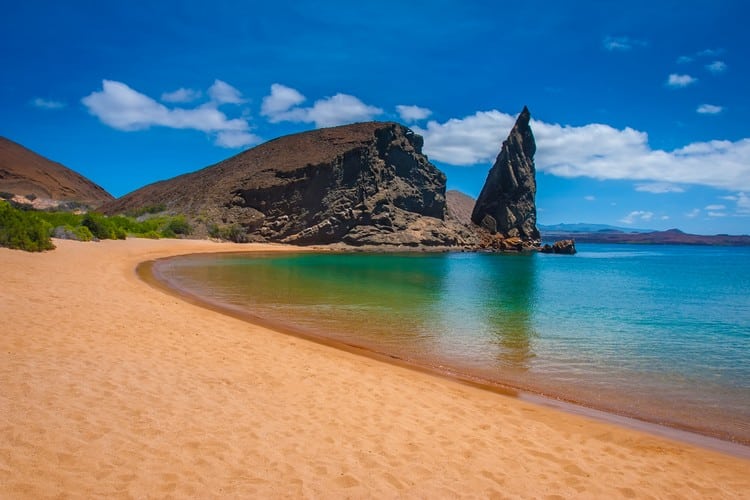
AM: Our destination for today is Genovesa Island, considered to be one of the wildest and most pristine islands in Galapagos National Park. Known as “Bird Island,” Genovesa is the only place where you will be able to see Red-footed boobies. After a wet landing at Genovesa Island’s Darwin Bay, we will walk along a short path that leads through the nesting sites of booby and frigatebird colonies. On the beach, you can observe the interesting spectacle of how frigate birds try to rob the prey of the different species of boobies.
PM: In the afternoon we will go ashore at a crater wall where Prince Phillip’s Steps are located. These stairs were carved in the stone wall and lead up to a wide plateau where you will find nesting places of great frigate birds, red-billed tropic birds, Bahama ducks, lava seagulls, and fork-tailed seagulls. During this easy stroll, we will cross a little scalesia wood where you can observe the short-eared owl. With a little bit of luck, you will also be able to observe the unique courtship carried out by various species of boobies (Red- and Blue-footed as well as masked boobies). It truly is a show. The same path will lead us back to your boat.
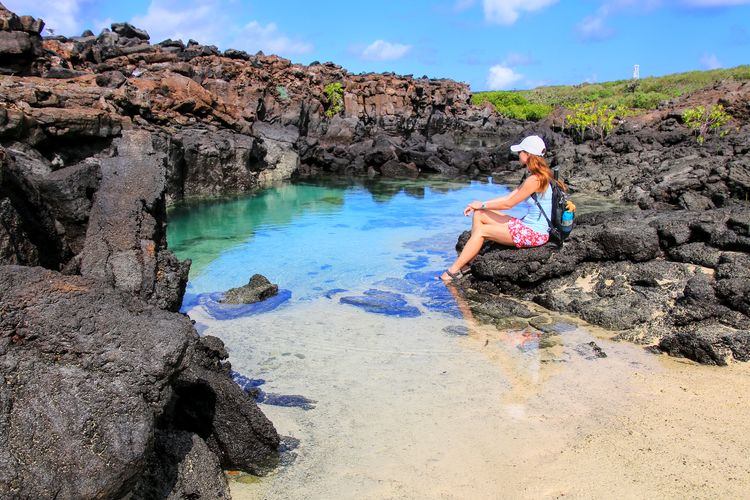
AM: This morning we will land on the fourth largest island in the Galapagos: Santiago Island, also known as “James Island” or “San Salvador Island.” The old rusted machines and run-down buildings of former salt mine workers are still apparent on the island, though the last attempts to populate Santiago Island were given up on forty years ago. We will visit Espumilla Beach, where marine iguanas relax and sea turtles nest. While snorkeling, you might find octopuses, morays and many types of tropical fish. There is also a Palo Santo forest close to this beach.
PM: Later in the day, we will have a wet landing on the dark sand beach of Puerto Egas, where you can find an abundance of marine iguanas. After a short walk of about 2 km along the coast, we will reach the rugged lava coastline. On these shores are natural pools where you can find sea lions, herons and other sea birds. The surrounding area is also a good spot for observing colonies of red Sally Light Foot crabs, lava lizards, Galapagos buzzards and lava herons.
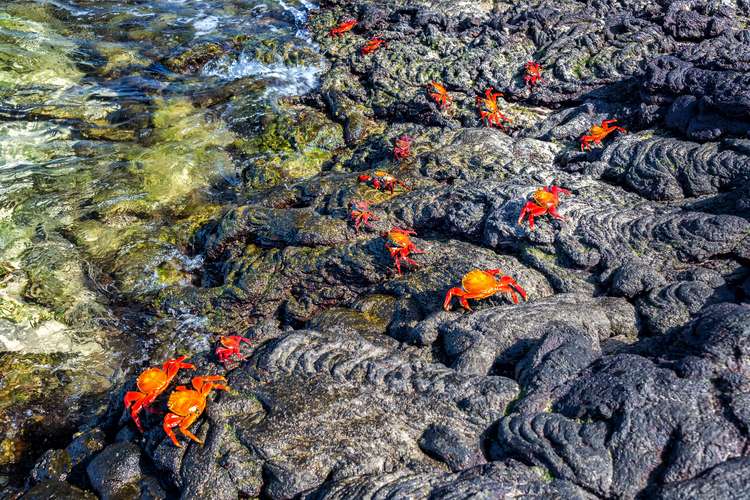
AM: After a dry landing on North Seymour Island, we will take a short walk along the coast. Here you will encounter Swallow-tailed gulls, sea lions and Cliff crabs. This part of Seymour Island is also known for being a major nesting site for Blue-footed boobies and the largest colony of Magnificent frigatebirds, a species different from the Great frigatebird. We can also spot both of the endemic species of iguanas: marine iguanas and land iguanas. You will enjoy this relaxing hike around the nesting sites.
PM: After lunch we will visit the highlands of Santa Cruz Island, where the lush landscape is a welcome contrast to the arid scenery of the smaller, lower islands. On the way, we will cross through different vegetation zones – from the dry lower region full of cactuses, to the scalesia woods in the Highlands. There one can find two small agricultural communities that grow the famous organic Galapagos coffee. While in the Highlands you will have the option of visiting one of two tortoise breeding centers: El Chato or Rancho Las Primicias. At either site, approaching these enormous and slow-moving reptiles is always an inspiring adventure. The El Chato tortoise reserve was founded in 1964 to allow visitors observe the island’s huge Galapagos turtles and White herons in their natural habitat. You will also be able to walk through nearby underground lava tunnels formed during volcanic eruptions. As the outside of the lava hardened, the inside continued to flow to the ocean, creating these tunnels. Alternatively, Rancho Primicias is a great place to see about ten to fifteen Galapagos giant tortoises in the wild. In addition to being able to view the ocean from this location in the Highlands, you can walk through a lava cave that was formed by a volcanic eruption.
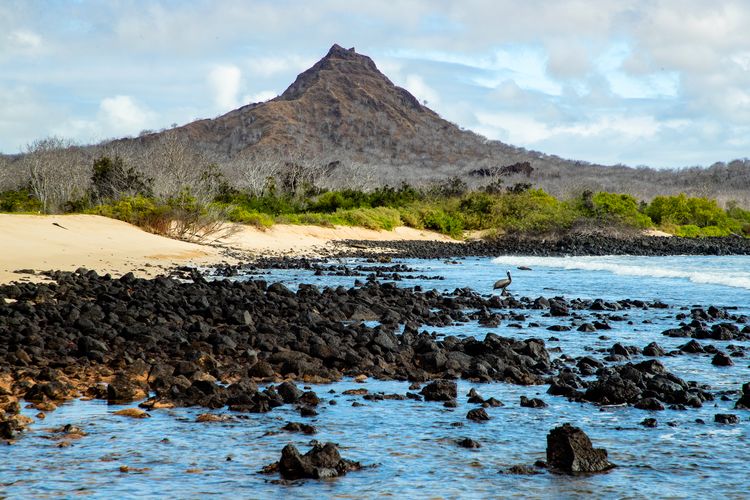
AM: Today we will anchor at Mosquera Island, which is located near Itabaca Channel and in between the Baltra and Seymour islands. The island consists of a long narrow stretch of white sand, rocks and small lagoons with large populations of sea lions. This is one of the best places to take photos of these aquatic mammals. A stroll down the beach also permits views of Brown pelicans and Blue-footed boobies.
PM: Afterwards, we will take a bus to Itabaca Channel, which we will cross to reach the Baltra Island airport for your flight back to the mainland. Enjoy the last view of the “enchanted islands,” a unique paradise with fascinating natural highlights.
Once you arrive in Quito your guide will pick you up and transfer to your hotel close to the airport, where you will spend your last night in Ecuador.
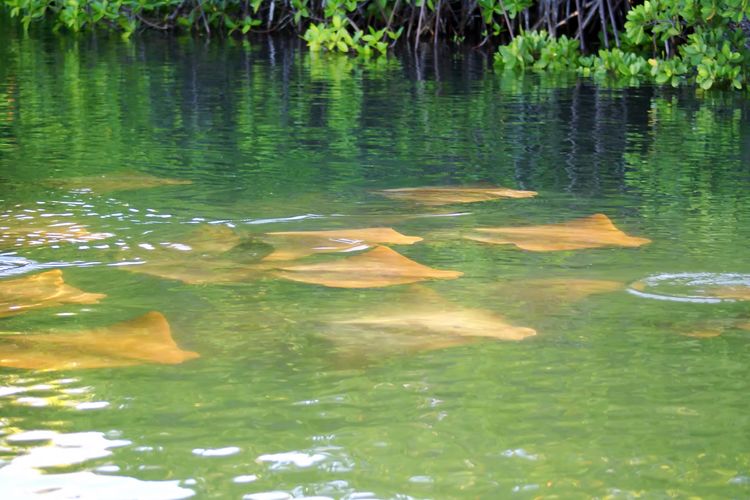
In the morning according to your flight schedule we will take you to the airport for your international flight home.
Thank you for traveling with Kuoda Travel, and buen viaje!
Like the sound of this Ecuador private tour? Get in touch with Kuoda and we’ll start devising your very own customized Ecuador private travel experience.
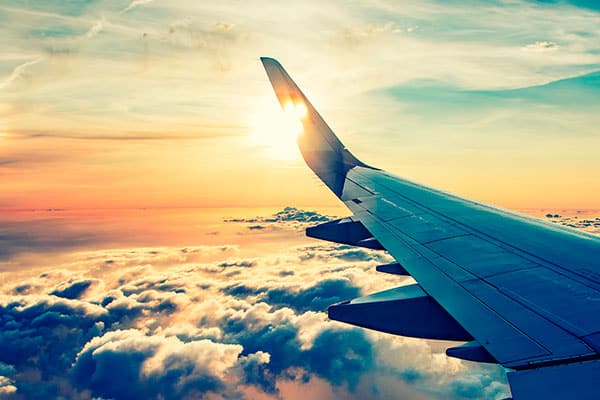
- Personalized itinerary planning
- A Kuoda host to assist you in every location
- Domestic flights
- The majority of meals in the itinerary
- Daily activities and excursions as indicated in the itinerary
- Galapagos National Park Entrance Fee & Transit Control Card
- International flights to and from your home country
- Travel insurance
- Meals not specified
- All gratuities
Talk with your Kuoda Travel expert to help find the right hotels for you during your personalized luxury tour.
Related Ecuador Tours
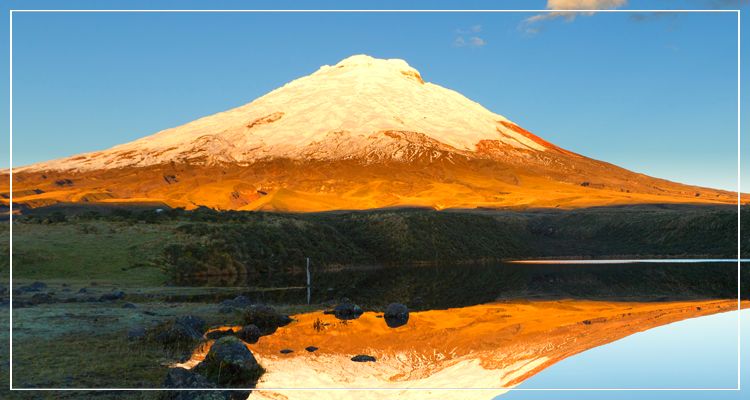
Our team of luxury travel specialists that have more than 30+ years of knowledge within South America’s travel industry. Our local insight of South America’s most inspiring places is unrivaled.

